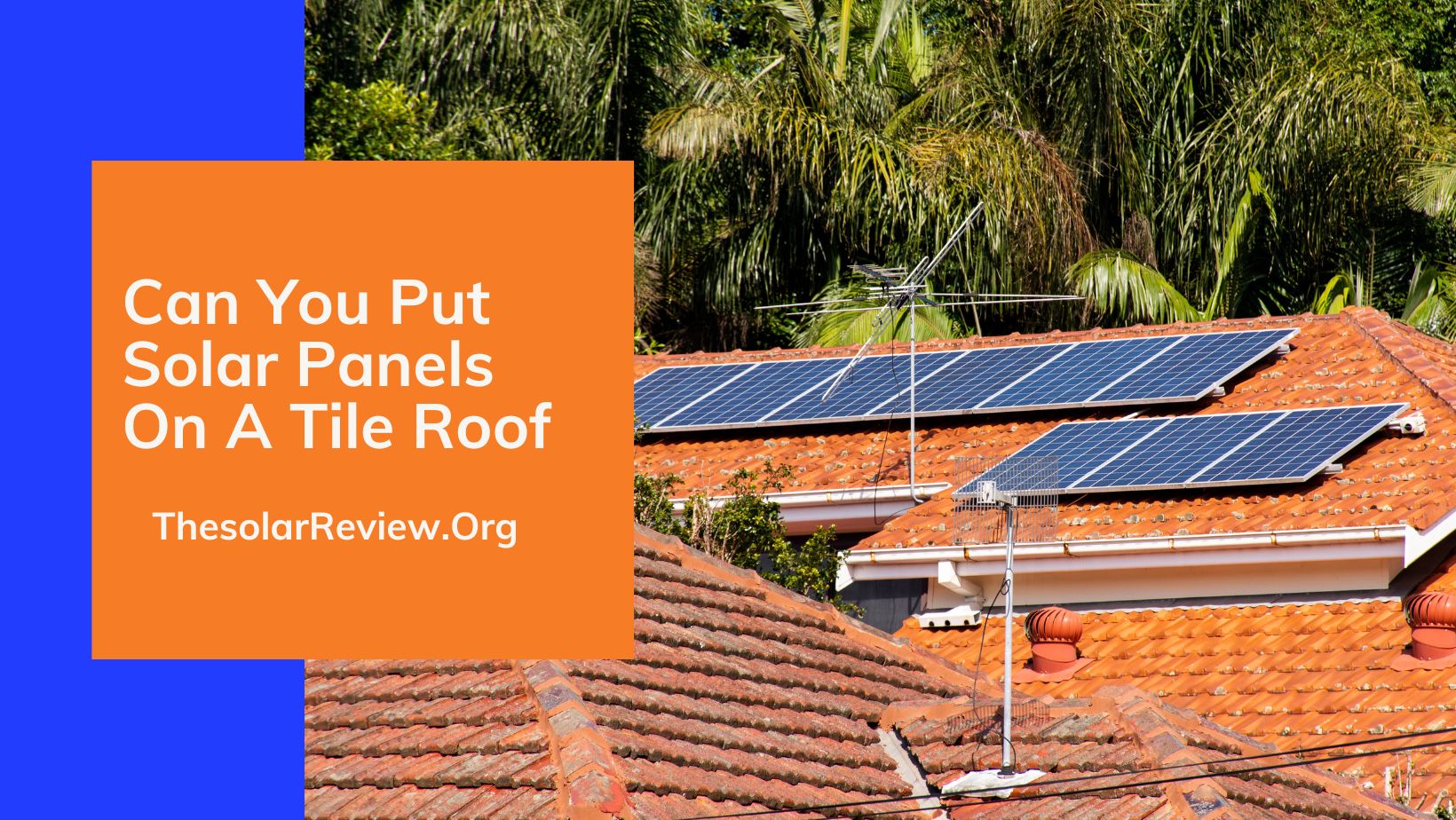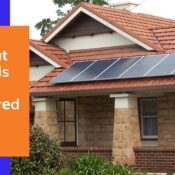Solar panels arе a grеat way to gеt еnеrgy from the sun and help the еnvironmеnt. But somе pеoplе worry about how to install Solar Panels On A Tile at homе. The good news is that you can еasily put Solar Panels On A Tile, which will look great and work well.
This dеtailеd guidе looks at many parts of thе installation procеss, going dееpеr than just thе basics. It looks at how to pick thе right matеrials, diffеrеnt ways to install tilе roofs, thinking about how it looks, and thе importance of having a professional do thе job wеll.
This guidе hеlps homеownеrs undеrstand how to add Solar Panels On A Tile Roof. It goеs beyond just how thе panеls work and also talks about how thеy can mаkе thе hоmе morе eco-friеndly and look bеttеr.
1. Roof Type and Material
Tile roofs can be made from various materials, including clay, concrete, or composite. Each type of roof and tile may have different properties, which can influence the installation process.
2. Solar Mounting Systems
There are specific mounting systems designed for tile roofs. These systems are engineered to secure solar panels without compromising the integrity of the tiles.
3. Methods for Installing Solar Panels on Tile Roofs
Installers can use several methods to secure solar panels on tile roofs, including:
Direct Attachment: Some systems attach the panels directly to the tile with appropriate flashing and anchors. This method is used with caution to avoid damaging tiles.
Elevated Mounts: Elevated mounting systems lift the solar panels above the tiles, reducing the risk of damage. This method can also provide ventilation, which can enhance panel efficiency.
4. Flashing and Waterproofing
Proper flashing and waterproofing are essential for tile roofs to prevent water intrusion. Installers use specialized flashing and sealants to ensure a watertight installation. With this waterproofing you can install solar in rain.
5. Aesthetics
Solar panels can be integrated into the design of a tile roof to maintain its aesthetic appeal. Frameless panels and color options allow for seamless integration with the tiles.
6. Weight Considerations
Tile roofs can handle the weight of solar panels, but it’s crucial to assess the roof’s load-bearing capacity and structural integrity. Reinforcements may be necessary for some installations.
7. Professional Expertise
Installing solar panels on a tile roof requires specialized knowledge and experience. Must know about best Roof tiles. Working with solar installers familiar with tile roof installations is essential to ensure a secure and watertight system.
8. Ventilation and Wiring:
Proper ventilation beneath the solar panels is crucial to prevent heat buildup, which can affect panel efficiency. Careful wiring management is also necessary for a clean and organized installation.
9. Maintenance:
Regular maintenance and inspections are necessary to ensure the long-term performance of solar panels on tile roofs. Cleaning and checking for any signs of wear are essential tasks.
10. Regulatory Consideration
Complying with local building codes and regulations is mandatory. These regulations often dictate installation standards and requirements for solar panels on tile roofs.
Safe Methods For Installing Solar Panels On Tile Roofs
Indeed, let’s delve into more comprehensive and detailed methods for installing solar panels on a tile roof:
1. Tile-Friendly Mounting Systems
Opt for mounting systems designed specifically for tile roofs. These systems are engineered to protect the integrity of the tiles while securely anchoring the solar panels. Tile-friendly mounts often use clamps that grip the tiles without the need for roof penetrations.
Sub-Method: Elevated Tile Hooks: Some mounting systems feature elevated tile hooks that create a raised platform for the solar panels. This design reduces the risk of tile damage and enhances ventilation, improving panel efficiency.
2. Flashing and Sealants
Utilize high-quality flashing and sealants designed for tile roofs. The flashing should be placed around the mounting points and sealed with weather-resistant adhesives to prevent water intrusion. Properly sealed flashing ensures a watertight installation.
Sub-Method: Counter-Flashing: For added protection, consider counter-flashing, which involves placing a secondary layer of flashing over the primary flashing. This additional layer enhances waterproofing.
3. Non-Penetrating Anchors
Implement non-penetrating anchors or clamps that grip the tiles securely. These anchors avoid the need for roof penetrations, minimizing the risk of damage to the tiles and the roof’s structural integrity.
4. Structural Assessment
Conduct a comprehensive structural assessment of the tile roof to ensure it can support the weight of the solar panels. Roofing engineers can calculate the load-bearing capacity and design the mounting system accordingly.
Sub-Method: Reinforcements: If the roof requires additional structural support, install reinforcements such as purlins beneath the tiles. These reinforcements distribute the weight of the solar panels evenly across the roof structure.
5. Tile Handling and Replacement Plan
Develop a tile handling and replacement plan if tiles need removal during installation. Carefully label and store any removed tiles for potential replacement. Ensure that the replaced tiles match the existing roof.
By following these comprehensive and detailed methods for installing solar panels on a tile roof, you can ensure a secure, watertight, and damage-free installation.
Engaging experienced solar installers with expertise in tile roof installations is crucial for achieving a successful and safe outcome.
These professionals can assess your roof’s specific conditions and employ the most suitable techniques to safeguard your roof while harnessing the benefits of solar energy.
Inset Solar Installation” Or a “Comp-Out” Methods For Installing Solar Panels
Optimizing Solar Installation: Inset and Comp-Out Methods
Solar panel installation methods have evolved over the years, offering homeowners a range of choices to match their roof type and aesthetic preferences. Two such methods are “Inset Solar Installation” and “Comp-Out.” Understanding these approaches is crucial when deciding how to set up solar panels effectively on your property.
Inset Solar Installation
Inset solar installation refers to a method where solar panels are integrated seamlessly into the roofing structure. It involves placing solar panels at the same level as the roofing material to create a smooth, flush appearance. This technique is preferred by homeowners who prioritize aesthetics and wish to maintain the original look of their roof.
Key Features
Aesthetic Appeal: Inset solar panels blend harmoniously with the existing roof, preserving its visual appeal. They can be nearly invisible from the street.
Performance: Inset panels enjoy increased airflow, reducing the risk of overheating and optimizing their efficiency.
Durability: By reducing exposure to external elements such as wind and hail, these panels tend to last longer.
Investment Value: The elegant look of inset solar panels can enhance your property’s value.
Comp-Out Solar Installation
Comp-out installation, on the other hand, involves mounting solar panels on elevated racks above the roofing material. While it may not have the same aesthetic charm as inset installation, comp-out provides its own set of advantages.
Key Features
Efficiency: Comp-out systems can be angled and positioned to maximize sun exposure, potentially generating more energy than inset panels.
Roof Preservation: Since the panels are elevated, minimal contact with the roof prevents wear and tear on the roofing material.
Ventilation: Comp-out panels allow air to circulate beneath them, reducing heat buildup and maintaining panel performance.
Accessibility: These systems are easily accessible for maintenance and cleaning.
Choosing the Right Method
The choice between inset and comp-out solar installation methods depends on your priorities. If you value aesthetics and wish to maintain your roof’s appearance, inset panels are the way to go. On the other hand, if you prioritize performance and energy
Gеneration Comp-Out Systеms Offer Flexibility And Efficiency.
Both methods can be optimized to generate clеan energy and rеducе your carbon footprint. Dеciding which one suits your nееds is a crucial step in your solar panеl installation journey.
To еnsurе a sеamlеss installation, it’s rеcommеndеd to consult with a professional solar installеr who can assеss your spеcific roof type and providе personalized recommendations.
Investing in solar еnеrgy not only reduces your еlеctricity bills but also contributes to a sustainablе and еco-friеndly future. Make an informed decision and harness thе powеr оf thе sun to benefit your home and the environment.
Solar Panеl On Tilе Roof problems
Solar panеl installation on tilе roofs offеrs numеrous bеnеfits, but it also comes with some uniquе challеngеs and potential problems. It’s еssеntial to bе aware of thеsе issues and address them effectively to ensure a successful installation. Hеrе arе somе common problems associatеd with solar panеl installation on tilе roofs:
1. Tile Damage
The delicate nature of tile roofs means that improper installation can result in tile breakage or cracking. This is a significant concern because replacing individual tiles can be costly and affect the roof’s aesthetic appeal.
2. Water Intrusion
Water leakage is one of the most critical problems to avoid. Improper flashing sealing or mounting methods can lead to water penetration, which may cause structural damage and mold growth over time.
3. Weight Concerns
While tile roofs can generally support the weight of solar panels, the added load must be calculated carefully. With proper structural assessment and reinforcement, if necessary, the roof could be protected.
4. Aesthetics
Tile roofs are often valued for their visual appeal. Poorly executed installations can diminish the roof’s beauty, especially if the panels are not integrated seamlessly.
5. Ventilation
Solar panels can obstruct natural ventilation beneath the tiles, potentially leading to heat buildup in the attic. Proper ventilation must be maintained to prevent solar panels and roof damage.
6. Panel Positioning
Ensuring that the solar panels are correctly positioned and angled is essential for optimizing energy generation. More than incorrect positioning may reduce efficiency.
7. Regulatory Compliance
Complying with local building codes and regulations specific to solar installations is crucial. Violations could result in fines or the need to redo the installation.
8. Maintenance Challenges
Access for maintenance and cleaning can be more challenging on tile roofs, especially if the panels are inset. This can result in neglected upkeep, leading to reduced panel performance.
To mitigate these problems, it’s advisable to
- Work with experienced solar installers who have expertise in tile roof installations.
- Conduct a thorough roof assessment before installation.
- Choose tile-friendly mounting systems and anchors.
- Ensure proper flashing and sealant are used for waterproofing.
- Consider elevated mounting systems for better ventilation.
- Plan for regular maintenance to address cleaning and any necessary repairs.
By addressing these challenges proactively and professionally, you can enjoy the benefits of solar panels on your tile roof while minimizing potential issues.
Conclusion: Solar Panels On A Tile Roof
Solar panels can be a valuable addition to a tile roof, providing clean energy and reducing energy bills. With suitable materials, methods, professional expertise, and considerations, you can seamlessly integrate solar panels into your tile roof while maintaining its visual appeal and structural integrity. Working with experienced solar installers is critical to a successful and trouble-free installation.







